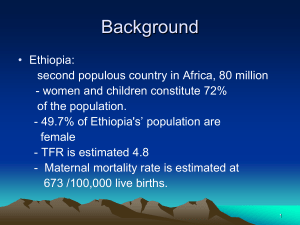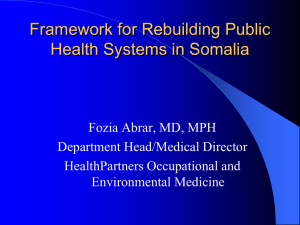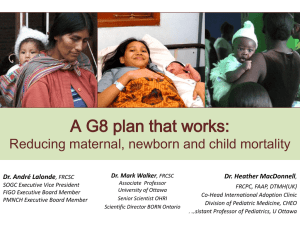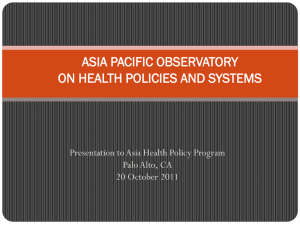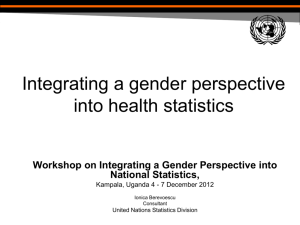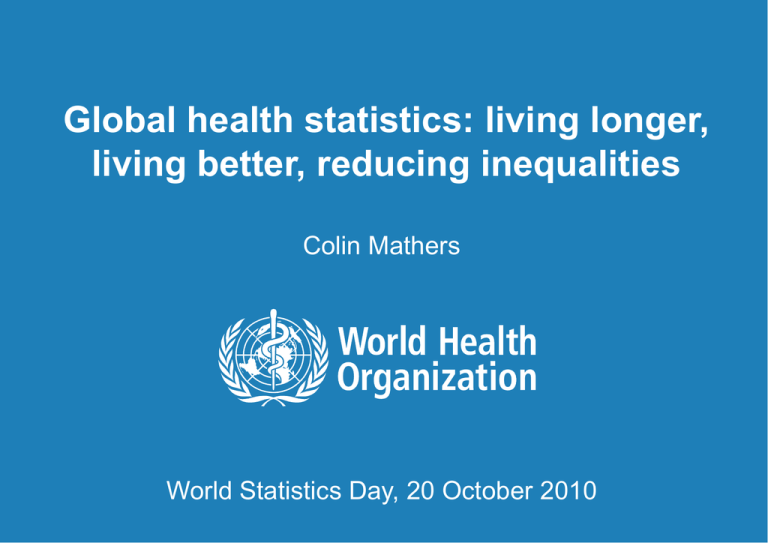
Global health statistics: living longer,
living better, reducing inequalities
Colin Mathers
World Statistics Day, 20 October 2010
Global health statistics
WHO is constitutionally mandated to
"establish and maintain ….. epidemiological and
statistical services" and
"assist in developing an informed public opinion among
all peoples on matters of health"
(WHO Constitution 1947)
2|
Global health observatory | April 9, 2015
Information & Evidence work at WHO
Data
Generation
Norms and
standards
Classifications and
terminology
Methods and tools for
data collection
(including ethics)
Multi-country
data collection
Population health surveys,
vital registration
Data
Compilation
Databases
Surveillance
Health information systems
(including population surveys)
Vital registration systems
Core indicators and
statistics
Disease-specific: eg. HIV,
TB, malaria
Dissemination
and use
Flagship
publications
World Health
Statistics
Disease registers
Registration data
Data archive
(surveys)
Health and healthrelated statistics
Life expectancy etc
Comprehensive
estimates
Burden of disease (overall
summary of lost healthy years)
Health
metrics
network
Global Health
Observatory
Health related MDGs
Deaths by cause, age, sex
Health research
Country system and
capacity building
Analysis and synthesis
of data
Comparative risk assessment
Systematic reviews
of evidence and
meta-analyses
WHO website
WHO Core Indicators
(DRAFT October 4, 2010)
Inputs & processes
Health financing
1
2
Total health expenditure
per capita
Government expenditure
on health as % of total
government expenditure
Health workforce
3
Health workers per
10,000 population
Outputs
Service access and
readiness
% deaths registered
7
8
9
5
11
National health strategy
having the main
attributes
12
Infrastructure
6
Health facilities per
10,000 population
4|
14 Antenatal care (4+)
13
Impact
Health status
33 Life expectancy at birth
Tracer medicines availability
in health facilities
16 DPT3 Immunization coverage
34 Child mortality (under-5)
17 % need of family planning satisfied
35 Maternal mortality ratio
Median price ratio for tracer
medicines
18 Children with ARI taken to health facility
Outpatient visits per person
per year
Service quality and safety
10
Governance
Coverage of interventions
15 Skilled birth attendance
Information
4
Outcomes
TB treatment success rate
(DOTS)
19 Children with diarrhoea receiving ORT
20 ITN use among children
21 ARV therapy
37 TB prevalence in adult
population
22 ARV prophylaxis among HIV+ women
38 HIV prevalence
23 Cervical cancer screening (20-64 years)
39 Notifiable diseases (IHR)
Risk factors and behaviours
30 day hospital case fatality
rate acute myocardial
infarction
24
Condom use at last higher risk sex
25
Access to safe water
Waiting time to elective
surgeries: cataract
26
Access to improved sanitation
27
Tobacco use (adults)
Surgical wound infection rate 28
(% of all surgical operations)
29
Global health observatory | April 9, 2015
36 Deaths by cause,age,sex
Low birth weight among newborns
Exclusive breastfeeding for 6 mths
30
Obesity in adults (over 15)
31
Children under 5 who are stunted
32
Alcohol consumption (adults)
Financial risk protection
40
Out of pocket as % of
total health expenditure
Global Health Observatory
www.who/gho
WHO's portal to data and analyses for monitoring global health.
Direct access to major databases
World Health Statistics online tables
Critical data and analyses for key health themes and indicators
Country profiles by theme: core health indicators, MDGs etc
Interactive data tables and visualisations
Indicator and Metadata Registry; standards for metadata
Topical reports: Women and Health, Africa
Resource inventory; web-based registry of country data reports
5|
Global health observatory | April 9, 2015
Database example: the WHO Mortality Database
http://www.who.int/healthinfo/morttables/en/
•Data are reported on an annual basis by country, year,
sex, age and cause of death from civil registries
• Causes of death are coded according to the International
Statistical Classification of Diseases and Related Health
Problems (ICD)
•Historical data since 1950 with data coded to ICD 6, 7, 8,
9 and 10th revision
•ICD 11th revision currently in alpha draft (release 2011)
6|
Global health observatory | April 9, 2015
Coverage of the WHO Mortality Database
WHO
Region
No of
Member
States
Afr
Amr
Emr
Eur
Sear
Wpr
TOTAL
46
35
21
53
11
27
193
Data
%
reported for Member
at least one
States
of the years reporting
2004-2008
4
32
6
46
3
8
99
Coverage
90+
75-89
50-74
<50 (sample)
<50
na
9
91
29
87
27
30
51
Of the reporting countries, half are developed providing 75% of the deaths
included, but only 33% of estimated global deaths
7|
Global health observatory | April 9, 2015
Cardiovascular disease mortality trends
Age standardized death rates (per 100 000)
All CVDs - Male - 60 years and over
6000
5000
4000
3000
2000
1000
0
1950
8|
1955
1960
1965
1970
1975
1980
1985
1990
Australia/New Zealand
Central Europe
Eastern Europe
Northern America
Western Europe
Eastern Asia and Mauritius
Global health observatory | April 9, 2015
1995
2000
Latin America
2005
2010
Analysis and synthesis: maternal mortality
Sources
Civil Registration
Number of
surveys
Number of
country-years
1891
1891
105
819
Population Censuses
18
19
Other (eg special surveys, verbal
autopsies, surveillance)
80
113
2094
2842
Surveys with Sibling Histories
Total
24 countries had no nationally representative data that met inclusion criteria
Trends for 172 countries 1990-2009 estimated by an interagency working group
- input data sets, analysis programs, estimates and report on WHO website
Maternal mortality ratios at country level
www.who.int/maternal_health/en
Is the pace of change sufficient?
MDG 6: Combat AIDS, malaria and other diseases
Prevalence of TB
Incidence of HIV infection
3.5
350
3
300
2.5
per 100 000 population
Number of people (in millions)
4
2
1.5
1
250
200
150
100
0.5
50
0
0
90 91 92 93 94 95 96 97 98 99 00 01 02 03 04 05 06 07 08
19 19 19 19 19 19 19 19 19 19 20 20 20 20 20 20 20 20 20
91 92 93 94 95 96 97 98 99 00 01 02 03 04 05 06 07 08
19 19 19 19 19 19 19 19 19 20 20 20 20 20 20 20 20 20
Malaria:
38 countries on track to reduce the malaria-related burden of disease
9 African countries; 29 outside Africa
The poorest are least likely to use health care:
especially use of skilled care during childbirth
Measles immunization coverage
Skilled birth attendants
100
Percentage
80
60
40
20
0
Poorest 20%
Data for 47 developing countries
Middle 20%
Least poor
20%
Types of health statistics
Unadjusted health statistics derived directly from primary
data collection with no adjustments or corrections.
Adjusted health statistics corrected to deal with known
biases, use of indirect techniques.
Predicted health statistics based on a model relating the
quantity of interest to covariates.
– Forecasting: past relationships to predict future
– Farcasting: missing primary data
13 |
Global health observatory | April 9, 2015
Comprehensive estimates: deaths by cause, age, sex
Adult mortality rates by major cause group and region, 2004
Cardiovascular diseases
High income
Cancers
Other noncommunicable diseases
Western Pacific
Injuries
HIVAIDS
Americas
Other infectious and parasitic diseases
Maternal and nutritional conditions
Eastern Mediterranean
South East Asia
Europe
Africa
0
2
4
6
8
10
Death rate per 1000 adults aged 15–59 years
12
Comparative risk assessment
Percentage of disability-adjusted life years (DALYs)
attributed to 19 leading risk factors, by country income level, 2004
Addressing the challenges
Assist Member States to build sound information systems that can
generate high frequency data to monitor change
Promote and assist countries to implement and scale up vital
registration systems
Work with research partners to develop innovative methods to collect
information on mortality and cause of death in populations without
vital registration (MOVE-IT)
Develop improved methods for dealing with incomplete and biased
health data to generate comparable estimates of core indicators
across countries
Improve transparency and replicability of statistics
Improve dissemination and access (Global Health Observatory)

